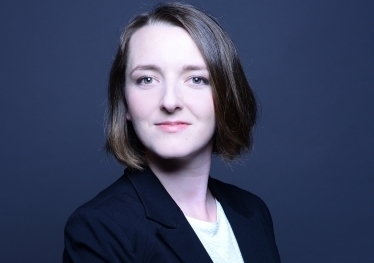HZB scientist got the dissertation prize at the spring conference of the Deutsche Physikalische Gesellschaft

Dr. Nele Thielemann-Kühn was awarded the Innomag Dissertation Award 2018. © Privat
Dr. Nele Thielemann-Kühn was awarded the dissertation prize of the magnetism research group at the spring conference of the Deutsche Physikalische Gesellschaft (German physical society/DPG) in Berlin. The prize is awarded for outstanding research in the field of magnetism.
Dr. Nele Thielemann-Kühn studied ultrafast magnetic dynamics in ferro- and antiferromagnetic dysprosium during her PhD work at the HZB and the University of Potsdam. Her dissertation, mentored at HZB by Dr. Christian Schüßler-Langeheine, included experiments with ultrashort X-ray pulses at BESSY II. She had already received the 2017 Ernst Eckhard Koch Prize for her dissertation and is now continuing research at Freie Universität Berlin.
Results have been published for example in Physical Review Letters (06 November 2017): Ultrafast and energy-efficient quenching of spin order: Antiferromagnetism beats ferromagnetism; Nele Thielemann-Kühn, Daniel Schick, Niko Pontius, Christoph Trabant, Rolf Mitzner, Karsten Holldack, Hartmut Zabel, Alexander Föhlisch, Christian Schüßler-Langeheine
DOI: 10.1103/PhysRevLett.119.197202
Highlighted as Focus story in "Physics": Quick Changes in Magnetic Materials
Web news to this publication: Future IT: Antiferromagnetic dysprosium reveals magnetic switching with less energy
red.
https://www.helmholtz-berlin.de/pubbin/news_seite?nid=14795;sprache=en
- Copy link
-
Synchrotron radiation sources: toolboxes for quantum technologies
Synchrotron radiation sources generate highly brilliant light pulses, ranging from infrared to hard X-rays, which can be used to gain deep insights into complex materials. An international team has now published an overview on synchrotron methods for the further development of quantum materials and technologies in the journal Advanced Functional Materials: Using concrete examples, they show how these unique tools can help to unlock the potential of quantum technologies such as quantum computing, overcome production barriers and pave the way for future breakthroughs.
-
Peat as a sustainable precursor for fuel cell catalyst materials
Iron-nitrogen-carbon catalysts have the potential to replace the more expensive platinum catalysts currently used in fuel cells. This is shown by a study conducted by researchers from the Helmholtz-Zentrum Berlin (HZB), Physikalisch-Technische Bundesanstalt (PTB) and universities in Tartu and Tallinn, Estonia. At BESSY II, the team observed the formation of complex microstructures within various samples. They then analysed which structural parameters were particularly important for fostering the preferred electrochemical reactions. The raw material for such catalysts is well decomposed peat.
-
Helmholtz Investigator Group on magnons
Dr Hebatalla Elnaggar is setting up a new Helmholtz Investigator Group at HZB. At BESSY II, the materials scientist will investigate so-called magnons in magnetic perovskite thin films. The aim is to lay the foundations for future terahertz magnon technology: magnonic devices operating in the terahertz range could process data using a fraction of the energy required by the most advanced semiconductor devices, and at speeds up to a thousand times faster.
